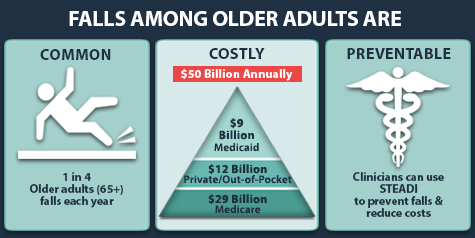
12 Nov Reduce Falls, Fear of Falling, and Near Misses
How Therapy Can Help With Fall Prevention
Trio Rehabilitation & Wellness Solutions opened in 2015 with the sole purpose of helping the older adult population navigate through the later years of life feeling healthier, more confidence, and fully capable of managing everyday activities; preventing falls and maintaining balance.
Every second of every day, an older adult (age 65+) suffers a fall in the U.S.—making falls the leading cause of injury and injury death for this age group.
As more and more people live well into retirement – nearly 10 thousand seniors turning age 65 every day, according to U.S. Daily News, we can expect to see more falls resulting from certain medications, vision problems, leg and core weakness, decreased balance, and home hazards.
Because falls are so common among aging adults, costing about $50 billion in annual healthcare, with $12 billion being paid directly or through private insurance (YIKES!), we feel obligated to share some useful food for thought on the topic of fall prevention, including reducing falls, the fear of falling, and near misses.
In this fall prevention post, we’ll cover:
- How our bodies support balance
- Fall prevention healthcare cost and insurance benefits
- How to set goals for improving balance and reducing falls
How do we balance ourselves?
Before we can discuss how a physical therapist or occupational therapist may assist with healthcare needs concerning falls and fall prevention, we must first discuss the topic of balance.
To have “balance” is to have an even distribution of weight, enabling someone or something to remain upright and steady (Oxford definition).
Our body uses three systems to support balance:
- Vestibular System (Inner Ear)
- Visual System (Eyesight & Visual Perception)
- Somatosensory System (Joint Position Sense & Strength)
Let’s Break it Down!
The Vestibular System reduces dizziness. In addition to ensuring we know which way is up, this body system helps our eyes and head work together when turning to look at something. If our head turned without the support of our vision, we would be left feeling dizzy. We can also feel dizzy when the “magical” crystals in our ears (which aren’t magical at all; they are called otoconia) are dislodged and not settled properly in the correct canal of our inner ear. Dizziness is a factor in our risk for falls, but can be addressed with simple exercises to restore good inner ear function.
The Visual System includes a lot more than having good visual acuity. Vision includes other components such as visual fields (the total area in which objects can be seen in your peripheral vision while you focus on a central point), depth perception, and the process in which your eyes move to watch a mobile target. Without the ability to see a potential hazard, such as water on the floor or a curb, due to a visual field loss or poor depth perception, there is an increased risk for falls or near misses!
The Somatosensory Systems entails core strength, lower extremity strength, knowing the space proximity of where we place our legs (proprioception), and endurance for movement. The loss of one of these areas of the somatosensory components can wreak havoc on postural control and balance causing an increased risk for falls.
How to assess fall potential?
As much as we want to believe that the people in the white medical coats automatically know the specific medical issues and unique concerns of every new patient they see, including fall potential and the fear of falling, they don’t. It is important for YOU – the patient to advocate for yourself and your health. The CDC published the STEADI Brochure – a guide to help assess the risk of falling, which can then be taken to a healthcare professional for further discussion and to assist in determining the need for intervention such as an exercise program or other support provided by a skilled physical therapist or occupational therapist.
How therapy supports fall prevention?
Physical therapists can assist with reducing the number of falls, the risk of falling, and the fear of falling by first conducting a thorough evaluation. A fall prevention evaluations includes an interview to discuss past experiences with falls and balance. A questionnaire is often administered to help determine confidence levels in performing daily activities. Based on what is discussed during the interview, therapists will perform a series of tests to assess vision, core and lower extremity strength, ability to walk on multiple types of surfaces while being distracted, endurance for activity, and balance with eyes open and closed. Once your physical therapist and you determine your “weak spot” then fall prevention goals are created to improve on that particular area.
Occupational therapists promote participation in life. When it comes to fear of falling people will often self limit their daily activities, especially in their own homes. Self limiting daily activities often lead to a sedentary lifestyle, which over time, leads to muscle weakness, decreased endurance, and depression and isolation. Occupational therapists meet older adults in their homes to conduct a home assessment. Home assessments should address fall hazards (such as clutter or cords on the ground), lighting, uneven surfaces around and inside the home, and the need for adaptive equipment, such as a shower chair. In addition, occupational therapists will address how to improve safety with outings such as going to the grocery store, library, or senior centers.
Will insurance pay for fall prevention?
 Absolutely!! Medicare and other insurances understand the cost associated with fall prevention and support consumers (that’s YOU) who seek out support to reduce their FEAR of falling, risk for falls, or reduce the number of falls already occurring.
Absolutely!! Medicare and other insurances understand the cost associated with fall prevention and support consumers (that’s YOU) who seek out support to reduce their FEAR of falling, risk for falls, or reduce the number of falls already occurring.
Remember to print and use the CDC’s STEADI Brochure when discussing your healthcare needs with your doctor.
What can I do on my own to get started with fall prevention?
Suzanne McCrum, Physical Therapist at Trio Rehab. Suggests three exercises.
1. Sit to Stands. Start with sit to stands WITHOUT using your hands to push up. Before you sit down for a meal, move from sitting to standing 10 times focusing on balancing evenly through both legs. Adults over the age of 40 typically move from sitting to standing well over 60 times a day. This movement is imperative to be able to get up and down from low surfaces, get up to hug someone who has entered your home, and sit back down without plopping onto the sitting surface.
2. Heel Raises. Complete heel raises 10-20 times while you brush your teeth or wash dishes. Heel raises address calf strength and without calf strength, we cannot push our legs forward to walk leading to trips.
3. Single Leg Stance. Stand on one leg and hold your balance for 10 seconds progressing to 30 seconds at a time. This, again, can be completed while you brush your teeth or wash dishes. If you truly think about walking, it’s a series of balance on one leg until the the other hits the ground. Being able to balance on leg strength the pelvis and upper leg allowing for better balance during the transition between one foot hitting the ground and the other foot lifting up.
We Can Help!
Your team of physical and occupational therapists can help with education about fall prevention, including reduced falls, fear of falling, and near misses. Call Trio Rehab for more information!
Suzanne McCrum
Suzanne McCrum, PT, DPT, CSRS, AIB (American Institute of Balance)
Trio Rehabilitation & Wellness Solutions
Boerne, Texas


